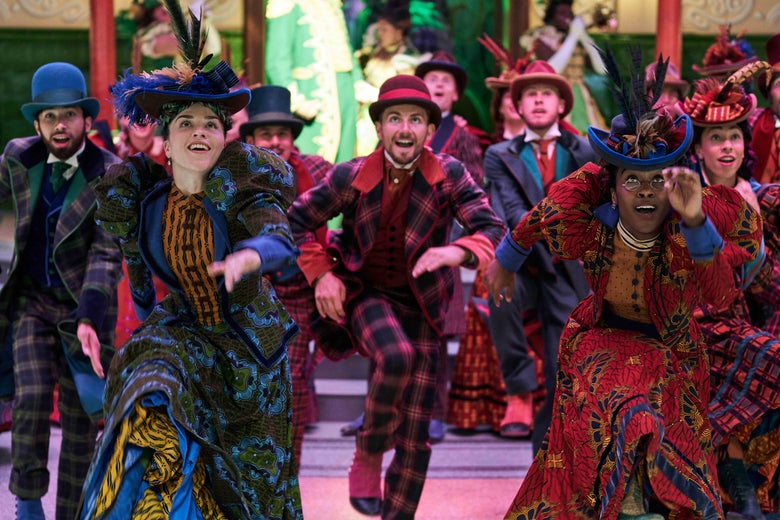
In a year where Radio City is shuttered by the pandemic, Netflix’s Jingle Jangle: A Christmas Journey is the closest thing we have to a big Christmas spectacular. It’s a cross between The Greatest Showman and Cats, bundled in shiny Christmas wrapping paper, with none other than John Legend as one of the minds behind the many songs packed into its two hours. At the center of that festive mishmash is an inventor named Jeronicus Jangle, a sentient doll, and a robot that, like Tinker Bell, is powered by belief. However, unlike Cats, David E. Talbert’s movie is a coherent, compelling story that doesn’t require booze or any other form of pregaming to be fully enjoyed. It’s the filmic equivalent of the high that comes from eating way too many candy canes and drinking way too much hot chocolate.
Forest Whitaker stars as Jeronicus, a toymaker whose creativity and joie de vivre have waned in the years since the matador doll Don Juan Diego (Ricky Martin), a Jeronicus creation capable of walking, talking, and thinking for himself, convinced his apprentice Gustafson (Keegan-Michael Key) to steal Jeronicus’ designs and pass them off as his own. While Gustafson, now known as “Magic Man G,” presides over a sprawling toy factory with Don Juan Diego as the devil on his shoulder, Jeronicus tinkers away doing small repairs for the local townspeople, unable to create anything new—all the while rebuffing the advances of the very horny and very single mail lady (Lisa Davina Phillip), whose amorous intentions are declared with the help of a dancing chorus. Jeronicus’ depression, compounded by the death of his wife, has alienated his daughter (Anika Noni Rose) and made him a bit of a Scrooge. However, when his granddaughter Journey (Madalen Mills), a would-be inventor herself, comes to visit, magic starts to seep slowly back into his life.
The unfolding tale involves math equations floating in the air as a visual representation of creative spark, with concepts like “sensational” and “impossible” serving as variables, and each major scene centering on a catchy musical number. (Legend, Philip Lawrence, Davy Nathan, and Michael Diskint are behind the songs.) Despite having ridiculously named characters, costumes, sets that seem to have been created by raiding every Christmas village in existence, and a plot that could have been conceived while on the aforementioned sugar high, the movie’s relative simple story and the strength of its acting help keep it grounded, and a little less zany than it might seem on the surface. In that respect, Jingle Jangle is closer to The Greatest Showman (sans the historically problematic hero and with less facile messaging) than Cats. It actually has a plot, enough that it’s easy to imagine Jingle Jangle being reworked for the stage, especially as Mills belts out Journey’s “I want” song, “Square Root of Possible,” which is a standout in Jingle Jangle’s stacked soundtrack.
The film also has the added benefit of featuring an almost entirely Black cast without patting itself on the back for its progressivism. (By contrast, Cats director Tom Hooper memorably described the film, which is about a bunch of cats introducing themselves and the things they like to do—drink milk, train cockroaches to dance—as being about “the dangers of tribalism.”) The (scant) social commentary that Jingle Jangle offers is buried in the motivations of its villains. Don Juan Diego’s fear of losing his individuality if Don Juan dolls are mass produced feels both reasonable and relatable; the problem is just that his pride leads him to commit, or at least enable, an outright crime. Gustafson, meanwhile, is motivated less by maliciousness but how tired he is of Jeronicus never having time for him, and being considered “just the apprentice” rather than an inventor in his own right. There’s also a brief nod toward class differences as Don Juan Diego, upon meeting Gustafson, points out how poorly he’s dressed in comparison to his master—as well as, in a very Parasite touch, noting that Gustafson smells. Meanwhile, Gustafson, once he hits it big, sings about how Christmas shopping will fill an emptiness in people’s souls. (Spoiler alert: It does not.)
Any self-awareness about capitalism stops there, but the holiday fantasy that Jingle Jangle sells is so potent that it doesn’t really matter. It’s a yuletide fantasy, a perfect theatrical work of holiday escapism, and a welcome breath of fresh air in Netflix’s otherwise mostly run-of-the-mill Christmas movie stable. Most of the streaming service’s offerings are the equivalent of Hallmark holiday rom-coms (A Christmas Prince, The Princess Switch), and even exceptions like Klaus and The Christmas Chronicles are still very Santa-centric. Jingle Jangle is mostly a Christmas movie by sheer force of will; the title and green, red, and gold aesthetic do a lot of legwork in making a story that’s mostly about believing in yourself specifically about the holidays. More than its loopy plot and breathless songs, it’s that sense of earnestness that really distinguishes Jingle Jangle. Of course, Cats was earnest too. But Jingle Jangle is an unquestionable upgrade, in a year when we’ve definitely earned one.